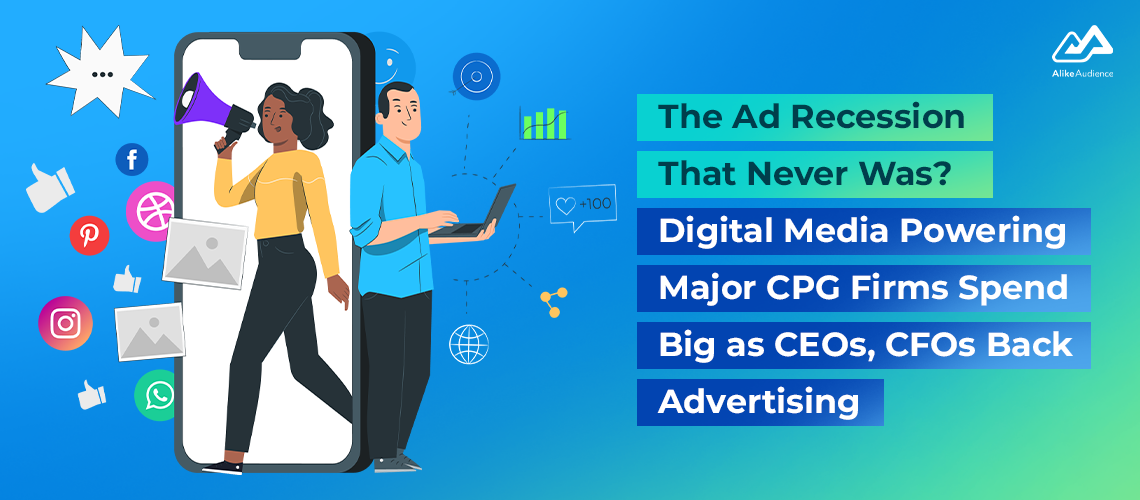
The collapse of tech stocks over the last year and resulting pullback from media and marketing has clouded some major pockets of growth.
US ad spend is back in black – and digital channels are powering. Meanwhile, bosses at some of the world’s largest advertisers are increasing spending and telling their investors in no uncertain terms that marketing is moving the needle.
Per latest data from Interpublic-owned Magna Global, US ad spend climbed 4.4. per cent in the second quarter, beating its earlier forecast of 3.6 per cent. The firm now expects 2023 ad spend to come in 5.2 per cent higher than 2022 – and forecasts the upturn to roll into 2024.
Digital channels, primarily search, commerce, social, and pureplay short-form video, up 8.7 per cent in Q2 according to Magna, are powering that growth. Traditional media remains depressed, with only out of home formats growing in Q2.
CPG goes large

Magna flagged spending increases from brands within travel, pharma and retail. Plus somewhat surprisingly, given inflationary pressures curbing consumer spending – CPG, i.e. food, drinks and personal care.
Other analysts have made the same observation. Brian Weiser, the former head of business intelligence at WPP’s media investment arm GroupM, now principal at Madison and Wall, has compiled a growing file of CEO and CFO statements from large CPG firms – plus luxury goods and financial services bosses – increasingly bullish on advertising.
Bosses at the likes of Nestlé (2021 annual ad spend $7.8m, according to AdAge), Mondelez, Beiersdorf, Kellogg and Capital One have all indicated that they are boosting ad investment.
Colgate-Palmolive CEO Noel Wallace this month told a Barclays-hosted investor conference that the firm will end the year with net increased spend.
“We'll continue to invest in building brand health and market shares and executing our pricing strategies and volume for the balance of the year. So advertising will be up on both the dollar and a percent to sales basis,” said Wallace. “Funding … advertising continues to accelerate the top line growth of the company.”
At the same conference, François-Xavier Roger, CFO at Nestlé – one of the world’s largest advertisers – indicated significant appetite to ramp up spending well into next year.
“We will continue to increase our marketing investment further than the second half of this year. We expect to go back to where we were a few years back, which means that we will need to ramp up even further the investments in 2024 as well.”
Meanwhile Jean-Jacques Guiony, CFO at LVMH, which spent $5.8bn on advertising in 2021, per AdAge, told investors that the firm has significantly upped the ante.
LVMH is now spending circa 12 percent of revenues on advertising and promotion, said Guiony. That suggests the luxury goods giant’s 2023 ad spend could top $10bn, given full year revenues look set to exceed €90bn ($96bn). Per LVMH’s first half 2023 results, the firm increased ad spend by 24 per cent year on year, helping to drive revenue growth by 15 per cent.
Solid growth from here
While the last year or so has inevitably seen slower growth in ad spend, versus the massive spike immediately post pandemic, Madison and Wall’s Wieser said the net result is a positive, “especially as much of the industry seemed to try to talk itself into a downturn last year by fearing for a recession that never came.”
From here, he suggests 4-5 per cent annual growth will become the US norm in the medium term – with higher growth of digital ad spend offset by traditional media declines.
Outside of search and social, both Weiser and Magna’s forecasts highlight ongoing strong growth for retail and commerce media, as well as connected TV.
Wieser predicts retail/commerce media revenues in the US will hit $42bn in 2023, much of which will accrue to Amazon, but Walmart may also notch circa $3.5bn if it can maintain its 30 percent YoY run-rate.
Proctor & Gamble, the world’s largest advertiser, indicates it may well spend more with retail-owned media channels – provided retailers can prove it’s driving growth.
“Just like any other channel, retailer media needs to earn its place in our marketing mix model based on the relative return that it can provide,” CFO Andre Schulten in July told investors. “[But] in many cases, a well-timed investment in retailer media in line with merchandising plans on the floor or online can provide superior return on investment.”
Open web to flatline?

According to Magna’s forecast, digital pure players will capture a record 69 per cent of total US ad spend in 2023 with the big three alone – Google, Meta and Amazon –capturing 59 percent.
By 2028, according to Madison and Wall’s Wieser, digital formats will account for fully 85 percent of total US ad spend, with the pureplays taking circa 75 percent.
He forecast little to no growth for non-walled garden publishers, i.e. the ‘open internet’ from here on in.
That’s not great news for the adtech firms, given they largely depend on the open internet to make money. But Weiser offered some hope:
“The ad tech sector … can grow at a faster rate, at least so long as insertion order-based sales continue to shift towards programmatic trading.”
Given Weiser’s forecast declines for legacy publishers and TV networks, in turn increasing pressure for cost efficiency, that next wave of programmatic growth may end up being sustained over multiple years.
For advertisers, that kind of environment may end up providing significant opportunities for better value – provided they know where to look.
